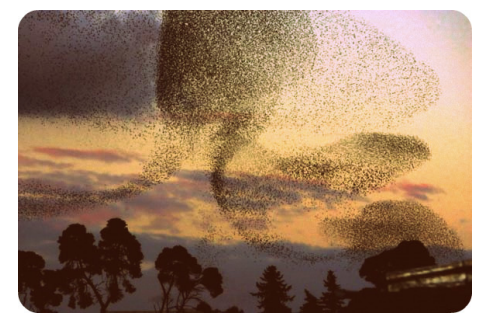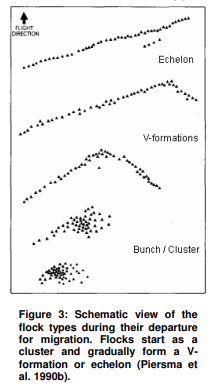created, $=dv.current().file.ctime & modified, =this.modified
tags: Birds
rel: V Formation

This thesis is a literature review, which concerns the three major questions of ‘When’, ‘How’ and ‘Why’ birds fly in flocks.
Flocks have roughly two shapes
- ball shaped clusters
- line formations (V or loose U shaped)
Cluster flight is commonly used throughout the year between roosting and foraging sites. Formation flight is specifically used for migration.
Previously believed to be coordinated by telepathy or electromagnetic communication, due to high-speed filming scientists have determined that these maneuvers are initiated by one individual bird and followed by the rest of the flock. The individual fulfilling the role of initiator changes from moment to moment.
Line shapes are theorized to have communicative and orientational advantages.
Flock
While living together in a flock, birds sometimes collectively burst into the air without an apparent cause.
Cluster to V-shape:
The actual departure is quite a happening to experience. Hours before the actual departure, the birds are already nervous and start flying around. When departing, small groups of birds tumble through the air noisily before joining together in a large group. First they are still flying in a cluster, like they also do outside the migrating periods, but quickly the cluster changes in a formation like a V-formation or an echelon.
 The orientation of migrating birds is based on landmarks (Adler 1970), celestial cues, like the sun (Moore 1987), skylight polarization patterns (Able 1982, Moore and Philips 1988, Helbig 1991), the stars (Sauer 1957, Emlen 1975) and geomagnetic cues.
The orientation of migrating birds is based on landmarks (Adler 1970), celestial cues, like the sun (Moore 1987), skylight polarization patterns (Able 1982, Moore and Philips 1988, Helbig 1991), the stars (Sauer 1957, Emlen 1975) and geomagnetic cues.
How?
Clusters have a three-dimensional structure. Clusters tend to be rather disorganized with frequent break offs and shifts of positions.
Sometimes clusters of birds may start out with unpredictable manoeuvres as a whole and then break up into smaller flocks that may cross over each other, recombine, and further separate (Camazine et al. 2003). This breaking up and recombining may further confuse a predator.
Theories (superceded)
- telepathy (Selous 1931)
- electromagnetic communication
- reaction times are smaller than humans so can adjust the directions fast
- “chorus line” - bird initiates move that spreads through the flock like a wave
Boids:
- flock centering: attempt to stay close to flock
- velocity matching - attempt to match velocity of flockmates
- collision avoidance - avoid nearby mates
Although J-formations and echelons are more often observed than true V-formations, the V formation is the most studied.
In U-formation the energy saves are more egalitarian spread.
Why?
Multiple individuals have a greater probability of detecting a predator. Less alert individuals benefit from the group. Multiple targets confuse.
Aerodynamic advantages hypothesis: When flying in the upwash of preceding birds, followers gain aerodynamic advantages which lead to energy savings.
Orientation and communication hypothesis: A skewed position relative to the bird in front of it enhances the orientation of a trailing bird. Vision might be essential in coordinated, close-order movements